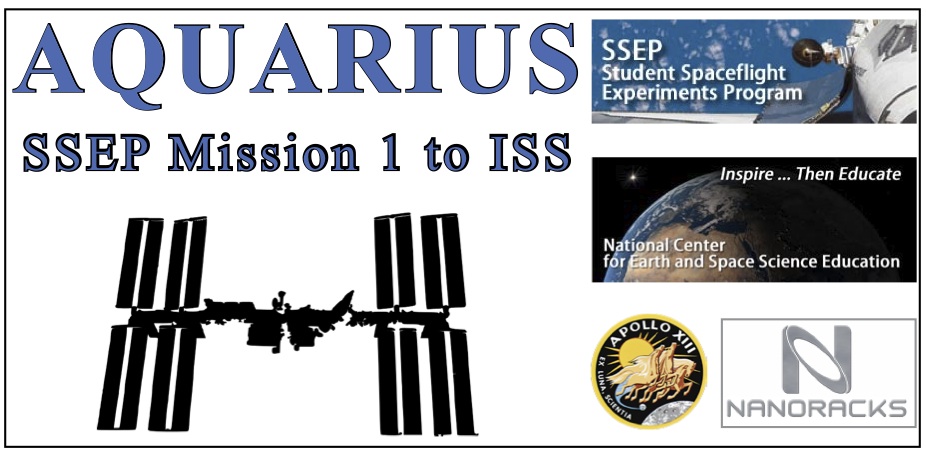 The SSEP Mission 1 payload, Aquarius, arrived at the International Space Station (ISS) aboard the SpaceX Dragon spacecraft on May 25, 2012. Over the past month, ISS crew members have worked with the payload, activating and deactivating experiments, as required. During this time, real microgravity science experiments designed by student teams from across the United States have been conducted aboard the International Space Station!
The SSEP Mission 1 payload, Aquarius, arrived at the International Space Station (ISS) aboard the SpaceX Dragon spacecraft on May 25, 2012. Over the past month, ISS crew members have worked with the payload, activating and deactivating experiments, as required. During this time, real microgravity science experiments designed by student teams from across the United States have been conducted aboard the International Space Station!
The first experiments were activated on Memorial Day, and to date, a total of 14 have been activated. Of these, nine have been deactivated to stop the experiment, and five will remain active through the end of the mission. The last remaining experiment will be activated at the end of June, just two days before the scheduled departure of the SSEP payload from the station. Below is the current status of each experiment in the SSEP Mission 1 payload. The times are given in terms of Greenwich Mean Time (GMT) and U.S. Eastern Daylight Saving Time (EDT).
Effect of Microgravity on the Antibacterial Resistance of P. aeruginosa (SSEPM1-01; San Marino, CA): Activated at 14:30 GMT (10:30 am EDT) on May 28, 2012. Deactivated at 20:30 GMT (4:30 pm EDT) on May 28, 2012.
Microgravity Wine (SSEPM1-02; West Hills, CA): Activated at 14:30 GMT (10:30 am EDT) on May 28, 2012. Deactivated at 20:30 GMT (4:30 pm EDT) on May 28, 2012.
How Does Parathyroid Hormone Affect Changes in Bone Mass in Microgravity? (SSEPM1-03; Hartford, CT): Activated at 14:30 GMT (10:30 am EDT) on May 28, 2012. Deactivated at 20:30 GMT (4:30 pm EDT) on May 28, 2012.
Does Hay Bacillus Break Down Human Waste (Represented by Brown Egg) in Microgravity as Well as in Earth Gravity? (SSEPM1-04; Washington, DC): Activated at 14:30 GMT (10:30 am EDT) on May 28, 2012. The experiment will remain active through the end of the mission.
Effect of Microgravity on Reproduction of Curli Producing E. coli O157:H7 438950R (SSEPM1-05; Avicenna Academy Science Community Collaboration, Lake County, Indiana): Activated at 14:30 GMT (10:30 am EDT) on May 28, 2012. Deactivated at 20:30 GMT (4:30 pm EDT) on May 28, 2012.
Killifish in Space (SSEPM1-06; Ida County, IA): Activated at 14:30 GMT (10:30 am EDT) on May 28, 2012. The experiment will remain active through the end of the mission.
The Physiological Effects of Microgravity and Increased Levels of Radiation on Wild-Type and Genetically Engineered Caenorhabditis elegans (SSEPM1-07; Charles County, MD): Activated at 17:16 GMT (1:16 pm EDT) on June 13, 2012. The experiment will remain active through the end of the mission.
Effect of Arthrobacter on Polyethylene Decomposition Rate in Microgravity (SSEPM1-08; Fitchburg, MA): Activated at 12:30 GMT (8:30 am EDT) on June 17, 2012. The experiment will remain active through the end of the mission.
Escherichia coli in Microgravity (SSEPM1-09; Pleasanton and Norris, NE): This experiment has not been activated. The target date for activation is June 29, 2012.
Spider Development and Gravity (SSEPM1-10; Cincinnati, OH): Deactivated at 20:30 GMT (4:30 pm EDT) on May 28, 2012.
Hepatocyte Development in Bioscaffolds infused with TGFB3 in Microgravity (SSEPM1-11; Houston, TX): Activated at 14:30 GMT (10:30 am EDT) on May 28, 2012. Deactivated at 20:30 GMT (4:30 pm EDT) on May 28, 2012.
The Effect of Microgravity on the Use of Cactus Mucilage for Water Purification (SSEPM1-12; El Paso, TX): Activated at 14:30 GMT (10:30 am EDT) on May 28, 2012. Deactivated at 20:30 GMT (4:30 pm EDT) on May 28, 2012.
Will Vitamin C Preserve Bone Density in Microgravity? (SSEPM1-13; Houston, TX): Activated at 14:30 GMT (10:30 am EDT) on May 28, 2012. The experiment will remain active through the end of the mission.
Yeast in Space! (SSEPM1-14; Cincinnati, OH): Activated at 14:30 GMT (10:30 am EDT) on May 28, 2012. Deactivated at 20:30 GMT (4:30 pm EDT) on May 28, 2012.
The Effect of Microgravity on the Quality and Nutritional Value of the Seed Sprout of a Germinated 92M72 Genetically-Modified Soy Bean (SSEPM1-15; Avicenna Academy Science Community Collaboration, Lake County, Indiana): Activated at 14:30 GMT (10:30 am EDT) on May 28, 2012. Deactivated at 20:30 GMT (4:30 pm EDT) on May 28, 2012.
The SSEP payload will return to Earth aboard Soyuz 29, which is scheduled to land on July 1, 2012. See the SSEP Mission 1 to the ISS Experiment Log for more information on the activities conducted with the payload.
The SSEP on-orbit research opportunity is enabled through NanoRacks LLC, which is working in partnership with NASA under a Space Act Agreement as part of the utilization of the International Space Station as a National Laboratory.

Comments are closed.